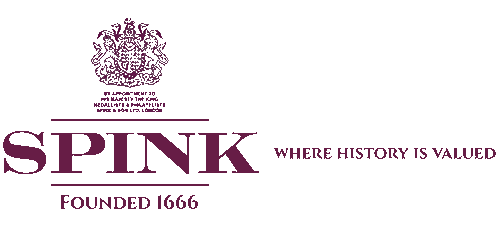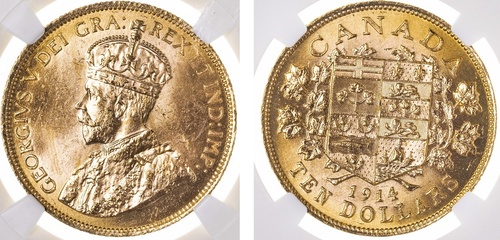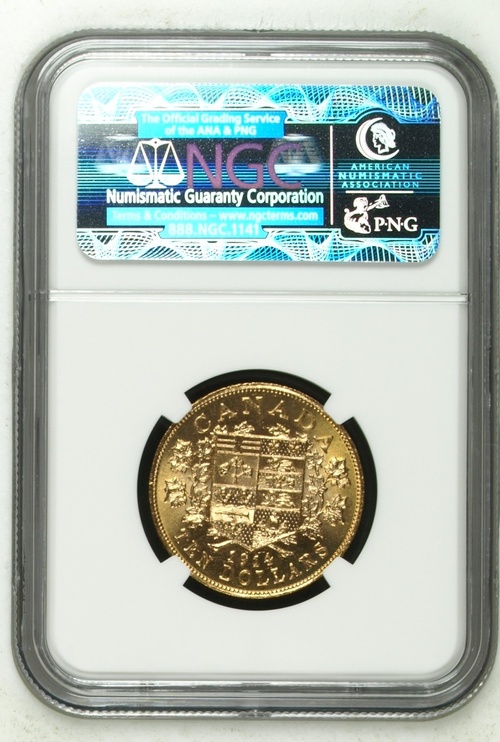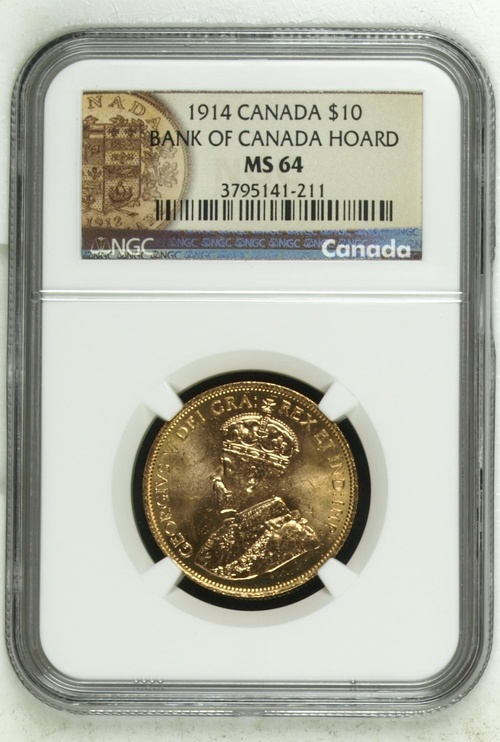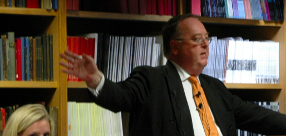Auction: 24126 - Spink Numismatic e-Circular 38: British and World Coins and Medals - e-Auction
Lot: 2365
(g) NGC MS64 | Canadian Gold Reserve | Canada, George V (1910-1936), 10-Dollars, 1914, Ottawa, crowned bust left, rev. garnished shield, edge milled, 12h, (KM 27; Fb. 3), a few pinmarks, otherwise with a most pleasing cartwheel lustre, about as struck, in NGC 'Bank of Canada' holder, graded MS64 (Cert. #3795141-211)
Provenance
Royal Mint, Collector Services (ref. HISG5C14), by private treaty, 20 April 2023
https://www.ngccoin.com/certlookup/3795141-211/64/
The Royal Canadian Mint began to sell off its stash of 1912-1914 dated $5 and $10 vintage gold coins in 2012 and ended that program in early 2014, selling 30,000 high-quality vintage coins containing 13,000 ounces of gold. The remaining lower-quality vintage coins were all refined so the government could sell the balance as gold bullion.
https://www.cbc.ca/news/business/gold-canada-reserves-1.3443700
https://www.cbc.ca/news/business/gold-canada-reserves-1.3475818
Canada decided to unload its gold reserves from 2000 to 2005, but the 1912 to 1914 coins were spared. In fact, they were the only coins that were left.
Then, late in 2012, the Bank of Canada and The Royal Canadian Mint announced that 30,000 of the $10 and $5 Gold coins would be released as "high-quality treasures of Canada's numismatic past".
They sold out instantly.
200,000 Coins Melted
And now there are no more out there because over the course of a few days, more than 200,000 gold coins were melted.
Approximately 95,586 ounces of gold was melted for a total value of $113,060,275 (US) at the time of melting.
The Royal Canadian Mint melted 35,341 of the .900 fine gold $5 coins, each weighing 8.36 grams and 179,881 of the .900 fine gold $10 coins, each weighing 16.72 grams.
These coins are iconic. History-making when they were first struck, they became legendary because of what happened next.
Almost all of the gold used for the coins came from the nearby Klondike River Valley in the Yukon Territory, the site of one of the largest and most frenzied gold rushes in history.
The newest fast-selling product from the Royal Canadian Mint is 100 years old.
The RCM, in a joint announcement Nov. 28 with the Bank of Canada, announced that it would immediately begin offering 1912, 1913 and 1914 Canadian $5 and $10 coins that the Bank of Canada vaults have held since the bank opened in 1935. Before that the coins were held by the nation's Ministry of Finance, which retains ownership of the coins today.
Several of the coins sold out after less than 48 hours on sale.
The series of coins were the nation's first exclusively Canadian gold coins. They were minted at the Ottawa Mint, which opened in 1908. The coins, featuring distinctly Canadian designs, were struck from gold mined in the nation, in 1912 mainly from the Klondike region, and in 1913 and 1914 from gold mined in Ontario.
The short-lived experiment with a domestic gold currency ended abruptly at the outbreak of World War I in 1914. The Government of Canada recovered the majority of circulating $5 and $10 coins and withheld remaining stocks from circulation to help finance the war effort.
Holding, offering the gold
The Bank of Canada has held approximately 245,000 King George V gold $5 and $10 coins dated 1912, 1913 or 1914 in the Exchange Fund Account controlled by the Minister of Finance.
In a tale reminiscent of the General Services Administration's sale of silver U.S. dollars from Treasury Department vaults in the 1970s, in total 30,000 coins were selected from Canadian bank vaults for sale to collectors. Funds raised from the sale of these coins, minus a fixed, undisclosed, management fee, will be converted into "high credit quality, marketable fixed income securities," the RCM states.
The remaining coins - those "bearing imperfections from handling or environmental conditions" - will be melted and refined into pure gold by the RCM, converting them into a tradable, liquid asset.
"We are delighted that these pieces of our history are back in the spotlight after a nearly century-long absence," said Ian E. Bennett, president and CEO of the Royal Canadian Mint.
The obverses of the coins carry a design by Sir Bertram Makennal featuring the effigy of King George V. The reverses, by W.H.J.
Blackmore, feature the inscription CANADA above a shield bearing the arms of the Dominion of Canada in a wreath of maple leaves, beneath which appear their year of issue and face value.
'Grading,' pricing the coins
RCM personnel separated the coins to be offered for sale into two classes of quality, designated "Premium Hand-Selected" and "Hand-Selected."
A disclaimer from the RCM notes that "the categories do not imply any form of coin grade, or suggestion thereof, derived from current numismatic grading standards."
Premium Hand-Selected coins are targeted at "collectors with the highest standards" and thus "feature maximum eye-appeal and nearly pristine quality. Their lustre is exceptional, as is the quality of their strike and their virtually unblemished surfaces."
Hand-Selected coins exhibit "a high quality appearance, with minimal evidence of wear caused by handling, storage, or environmental conditions," and are more affordable so more collectors can obtain the historic coins, according to the RCM.
Alex Reeves, RCM senior manager of communications, addressed the conditions of the coins: "The bottom line is that we don't grade coins. However we did work with a professional grader to sort the coins in terms of esthetic quality. Our goal was to offer up the 'cream of the crop' if you will, without getting into anything that suggests a grade."
That led to the creation of the two category designations.
"The rest of the coins destined for melting have too many bag marks or wear to be sold as a high quality product," Reeves said.
The RCM also had an eye to the numismatic marketplace when determining what and how many coins to sell, Reeves said.
"Our goal is not to flood the marketplace with too many coins," he said.
The coins are expected to ship in January.
The melting of the remaining coins has not begun and no date for that step has been chosen yet.
If all 30,000 coins chosen for the offering are sold at the stated prices, the sale will reap $30,183,750 for the government, minus the RCM's fees.
In total, 140 six-coin sets were created from the coins being offered to the public, with the coins in the sets representing the finest in the entire collection. All of those coins are "Premium Hand-Selected." The set is the only way to obtain the 1912 gold $10 coin designated in that condition.
Set packaging includes a Canadian maple wood box and one of the canvas bags that held the coins in the Bank of Canada vaults. The sets retail for $12,000 Canadian, and the public is limited to the purchase of one set.
In total, 291 gold $5 coins designated Premium Hand-Selected were offered to the public, for $875 each, and those sold out quickly.
In total, 4,869 Premium Hand-Selected gold $10 coins were made available for $1,750 each, and sales were ongoing at press time Nov. 30.
The RCM offered 5,050 of the Hand-Selected gold $5 coins for $500 each, with sales of the 1912 and 1914 coins already sold out.
In total, 18,950 Hand-Selected gold $10 coins are being offered for $1,000 each, with sales ongoing at press time.
The individual coins are secured inside a capsule with a silver holographic seal and then packaged in a black RCM clamshell case.
Sales of the Hand-Selected coins are limited to three per household, regardless of date.
Purchasers are limited to a single Premium Hand-Selected coin of any date or one six-coin set.
Sales of the set are restricted to telephone orders, with the other coins offered through a special page at the RCM website, www.mint.ca/1912gold. Telephone orders for the coins are accepted at 1-800-267-1871 in Canada and 1-800-268-6468 in the United States.
RCM distributors also expected to acquire some of the coins, but in some cases only limited quantities, and could not provide availability or pricing until the coins are delivered in January.
By far the most abundant coins in the sale of individual coins are the 1913 and 1914 $10 coins, which together total 22,763 coins, accounting for 75.8 percent of the reserves being offered.
The rarest coin being offered individually is the 1914 gold $5 coin.
Subject to 20% VAT on Buyer’s Premium. For more information please view Terms and Conditions for Buyers.
Sold for
£950
Starting price
£700
